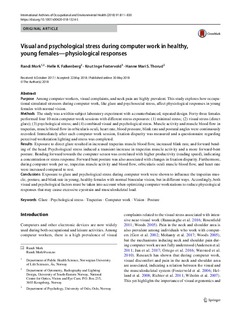| dc.contributor.author | Mork, Randi | |
| dc.contributor.author | Falkenberg, Helle Kristine | |
| dc.contributor.author | Fostervold, Knut Inge | |
| dc.contributor.author | Thorud, Hanne Mari Schiøtz | |
| dc.date.accessioned | 2018-10-05T06:45:30Z | |
| dc.date.available | 2018-10-05T06:45:30Z | |
| dc.date.created | 2018-07-09T19:18:49Z | |
| dc.date.issued | 2018 | |
| dc.identifier.citation | International Archives of Occupational and Environmental Health. 2018, 1-20. | nb_NO |
| dc.identifier.issn | 0340-0131 | |
| dc.identifier.uri | http://hdl.handle.net/11250/2566544 | |
| dc.description | This article is distributed under the terms of the Creative Commons Attribution 4.0 International License, which permits unrestricted use, distribution, and reproduction in any medium, provided you give appropriate credit to the original author(s) and the source, provide a link to the Creative Commons license, and indicate if changes were made. | nb_NO |
| dc.description.abstract | Purpose
Among computer workers, visual complaints, and neck pain are highly prevalent. This study explores how occupational simulated stressors during computer work, like glare and psychosocial stress, affect physiological responses in young females with normal vision.
Methods
The study was a within-subject laboratory experiment with a counterbalanced, repeated design. Forty-three females performed four 10-min computer-work sessions with different stress exposures: (1) minimal stress; (2) visual stress (direct glare); (3) psychological stress; and (4) combined visual and psychological stress. Muscle activity and muscle blood flow in trapezius, muscle blood flow in orbicularis oculi, heart rate, blood pressure, blink rate and postural angles were continuously recorded. Immediately after each computer-work session, fixation disparity was measured and a questionnaire regarding perceived workstation lighting and stress was completed.
Results
Exposure to direct glare resulted in increased trapezius muscle blood flow, increased blink rate, and forward bending of the head. Psychological stress induced a transient increase in trapezius muscle activity and a more forward-bent posture. Bending forward towards the computer screen was correlated with higher productivity (reading speed), indicating a concentration or stress response. Forward bent posture was also associated with changes in fixation disparity. Furthermore, during computer work per se, trapezius muscle activity and blood flow, orbicularis oculi muscle blood flow, and heart rate were increased compared to rest.
Conclusions
Exposure to glare and psychological stress during computer work were shown to influence the trapezius muscle, posture, and blink rate in young, healthy females with normal binocular vision, but in different ways. Accordingly, both visual and psychological factors must be taken into account when optimizing computer workstations to reduce physiological responses that may cause excessive eyestrain and musculoskeletal load. | nb_NO |
| dc.language.iso | eng | nb_NO |
| dc.publisher | Springer Berlin Heidelberg | nb_NO |
| dc.rights | Navngivelse 4.0 Internasjonal | * |
| dc.rights.uri | http://creativecommons.org/licenses/by/4.0/deed.no | * |
| dc.title | Visual and psychological stress during computer work in healthy, young females' physiological responses | nb_NO |
| dc.title.alternative | Visual and psychological stress during computer work in healthy, young females' physiological responses | nb_NO |
| dc.type | Journal article | nb_NO |
| dc.type | Peer reviewed | nb_NO |
| dc.description.version | publishedVersion | nb_NO |
| dc.rights.holder | © The Author(s) 2018 | nb_NO |
| dc.source.pagenumber | 1-20 | nb_NO |
| dc.source.journal | International Archives of Occupational and Environmental Health | nb_NO |
| dc.identifier.doi | 10.1007/s00420-018-1324-5 | |
| dc.identifier.cristin | 1596448 | |
| cristin.unitcode | 222,56,2,0 | |
| cristin.unitname | Institutt for optometri, radiografi og lysdesign | |
| cristin.ispublished | true | |
| cristin.fulltext | original | |
| cristin.qualitycode | 1 | |

